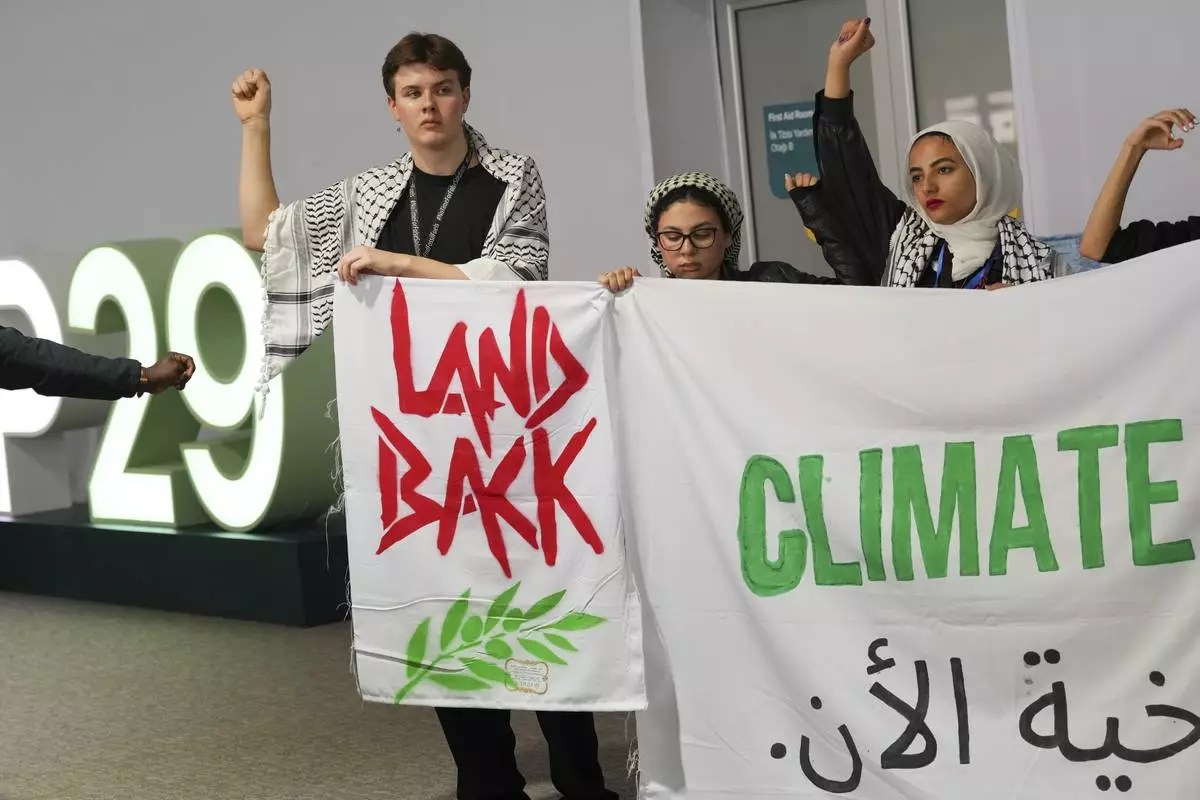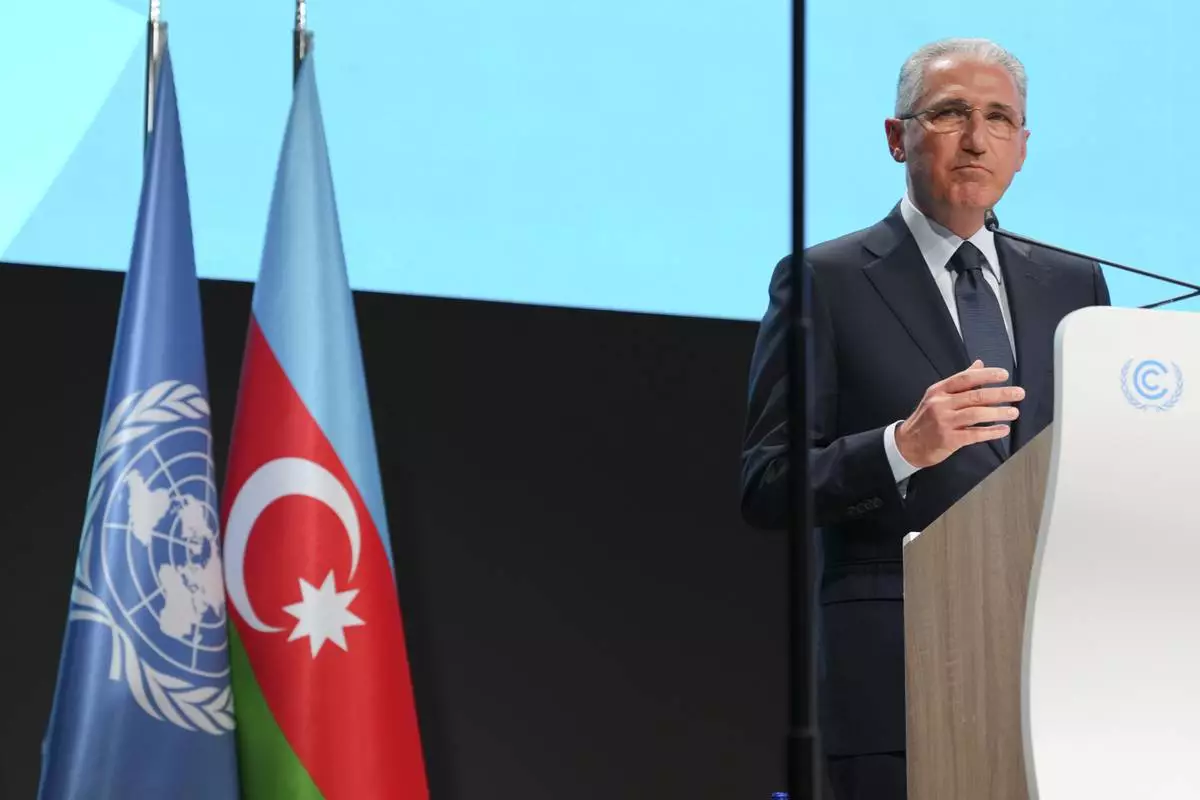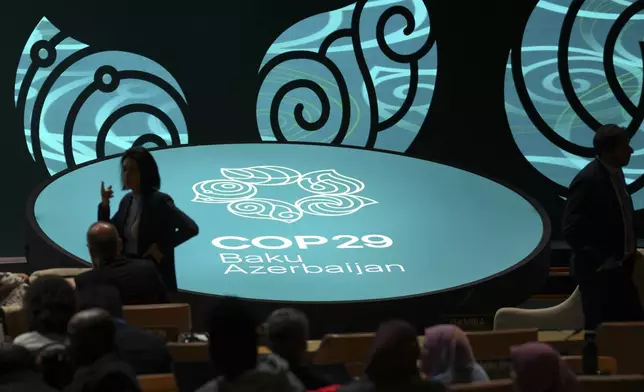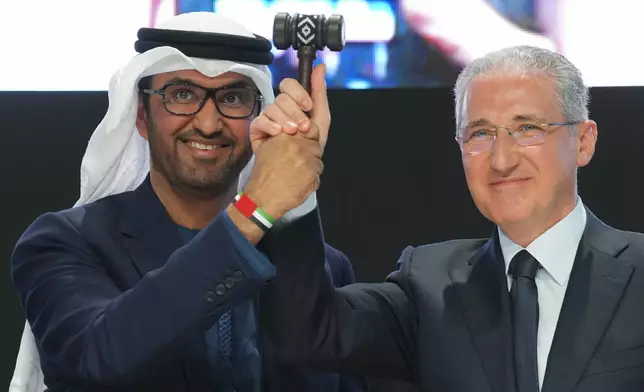BAKU, Azerbaijan (AP) — United Nations annual climate talks stuttered to a start Monday with more than nine hours of backroom bickering over what should be on the agenda for the next two weeks. It then turned to the main issue: money.
In Baku, Azerbaijan, where the world’s first oil well was drilled and the smell of the fuel was noticeable outdoors, the talks were more about the smell of money — in huge amounts. Countries are negotiating how rich nations can pay up so poor countries can reduce carbon pollution by transitioning away from fossil fuels and toward clean energy, compensate for climate disasters and adapt to future extreme weather.
In order to try to start the 12 days of talks, called COP29, with a win, Monday's session seemed to find a resolution to a nagging financial issue about trading carbon pollution rights — one that has eluded negotiators for years. It could free up to $250 billion in spending a year to help poor nations, said new COP29 president, Mukhtar Babayev.
But Erika Lennon, Center for International Environmental Law’s Senior Attorney, warned that pushing through resolutions this early in the conference “without discussion or debate, sets a dangerous precedent for the entire negotiation process.”
When it comes to discussions on finance, the amount of money being talked about to help poor nations could be as high as $1.3 trillion a year. That's the need in the developing world, according to African nations, which have produced 7% of the heat-trapping gases in the air but have faced multiple climate crises, from floods to drought.
Whatever amount the nations come up with would replace an old agreement that had a goal of $100 billion a year. Richer nations have wanted numbers closer to that figure. If an agreement is struck, money is likely to come from a variety of sources including grants, loans and private finance.
“These numbers may sound big but they are nothing compared to the cost of inaction,” Babayev, said as he took over.
This year, the world is on pace for 1.5 degrees of warming and is heading to become the hottest year in human civilization.
A goal of limiting warming to 1.5 degrees Celsius (2.7 degrees Fahrenheit) since pre-industrial times was set in the Paris Agreement in 2015. But that's about two or three decades, not one year of that amount of warming and “it is not possible, simply not possible,” to abandon the 1.5 goal yet, said World Meteorological Organization Secretary-General Celeste Saulo.
The effects of climate change in disasters such as hurricanes, droughts and floods are already here and hurting, Babayev said.
“We are on the road to ruin,” he said. “Whether you see them or not, people are suffering in the shadows. They are dying in the dark. And they need more than compassion. More than prayers and paperwork. They are crying out for leadership and action.”
United Nations Climate Secretary Simon Stiell, whose home island of Carriacou was devasted earlier this year by Hurricane Beryl, used the story of his neighbor, an 85-year-old named Florence, to help find “a way out of this mess.”
Her home was demolished and Florence focused one thing: “Being strong for her family and for her community. There are people like Florence in every country on Earth. Knocked down, and getting back up again.″
That’s what the world must do with climate change, Stiell said.
In the past year, nation after nation has seen political upheaval, with the latest being in the United States — the largest historic carbon emitter — and Germany, a climate leading nation.
The election of Donald Trump, who disputes climate change and its impact, and the collapse of the German governing coalition are altering climate negotiation dynamics here, experts said.
“The global north needs to be cutting emissions even faster ... but instead we’ve got Trump, we’ve got a German government that just fell apart because part of it wanted to be even slightly ambitious (on climate action),” said Imperial College London climate scientist Friederike Otto. “We are very far off.”
Initially, Azerbaijan organizers hoped to have nations across the globe stop fighting during the negotiations. That didn't happen as wars in Ukraine, Gaza and elsewhere continued.
Dozens of climate activists at the conference — many of them wearing Palestinian kaffiyehs — held up banners calling for climate justice and for nations to “stop fueling genocide.”
“It's the same systems of oppression and discrimination that are putting people on the frontlines of climate change and putting people on the front lines of conflict in Palestine,” said Lise Masson, a protester from Friends of the Earth International. She slammed the United States, the U.K. and the EU for not spending more on climate finance while also supplying arms to Israel.
Mohammed Ursof, a climate activist from Gaza, called for the world to “get power back to the Indigenous, power back to the people.”
Jacob Johns, a Hopi and Akimel O’odham community organizer, came to the conference with hope for a better world.
“Within sight of the destruction lies the seed of creation,” he said at a panel about Indigenous people’s hopes for climate action. “We have to realize that we are not citizens of one nation, we are the Earth.”
The financial package being hashed out at this year's talks is important because every nation has until early next year to submit new — and presumably stronger — targets for curbing emissions of heat-trapping gases from the burning of coal, oil and natural gas.
How much money is on the table could inform how ambitious some nations can be with their climate plans.
Some Pacific climate researchers said that the amount of money on offer was not the biggest problem for small island nations, which are some of the world’s most imperiled by rising seas.
“There might be funding out there, but to get access to this funding for us here in the Pacific is quite an impediment,” said Hilda Sakiti-Waqa, from the University of the South Pacific in Fiji. “The Pacific really needs a lot of technical help in order to put together these applications.”
And despite the stalled start, there was still a sense of optimism.
“My experience right now is that countries are really here to negotiate,” said German climate envoy Jennifer Morgan.
“We cannot leave Baku without a substantial outcome,” Stiell said. “Now is the time to show that global cooperation is not down for the count. It is rising to the moment.”
Associated Press reporter Charlotte Graham-McLay in Wellington, New Zealand contributed.
Read more of AP’s climate coverage at http://www.apnews.com/climate-and-environment
Follow Seth Borenstein on X at @borenbears and Melina Walling at @MelinaWalling
The Associated Press’ climate and environmental coverage receives financial support from multiple private foundations. AP is solely responsible for all content. Find AP’s standards for working with philanthropies, a list of supporters and funded coverage areas at AP.org.

People arrive for an opening plenary session at the COP29 U.N. Climate Summit, Monday, Nov. 11, 2024, in Baku, Azerbaijan. (AP Photo/Peter Dejong)

Simon Stiell, United Nations climate chief, left, and Mukhtar Babayev, COP29 President, speak at an opening plenary session during the COP29 U.N. Climate Summit, Monday, Nov. 11, 2024, in Baku, Azerbaijan. (AP Photo/Peter Dejong)

People walk outside the venue for the COP29 U.N. Climate Summit, Monday, Nov. 11, 2024, in Baku, Azerbaijan. (AP Photo/Rafiq Maqbool)

Celeste Saulo, World Meteorological Organization secretary-general, speaks during a session at the COP29 U.N. Climate Summit, Monday, Nov. 11, 2024, in Baku, Azerbaijan. (AP Photo/Sergei Grits)

Women walk through the COP29 U.N. Climate Summit, Monday, Nov. 11, 2024, in Baku, Azerbaijan. (AP Photo/Rafiq Maqbool)

Activists demonstrate for climate justice and a ceasefire in the Israel-Hamas at the COP29 U.N. Climate Summit, Monday, Nov. 11, 2024, in Baku, Azerbaijan. (AP Photo/Peter Dejong)

Activists demonstrate for climate justice and a ceasefire in the Israel-Hamas at the COP29 U.N. Climate Summit, Monday, Nov. 11, 2024, in Baku, Azerbaijan. (AP Photo/Rafiq Maqbool)

People walk through an exhibit in the Green Zone at the COP29 U.N. Climate Summit, Monday, Nov. 11, 2024, in Baku, Azerbaijan. (AP Photo/Sergei Grits)

A person walks outside the Baku Olympic Stadium, the venue for the COP29 U.N. Climate Summit, Sunday, Nov. 10, 2024, in Baku, Azerbaijan. (AP Photo/Rafiq Maqbool)

People walk through an exhibit in the Green Zone at the COP29 U.N. Climate Summit, Monday, Nov. 11, 2024, in Baku, Azerbaijan. (AP Photo/Sergei Grits)

Simon Stiell, United Nations climate chief, speaks during the opening plenary session with images of Hurricane Beryl displayed at the COP29 U.N. Climate Summit, Monday, Nov. 11, 2024, in Baku, Azerbaijan. (AP Photo/Peter Dejong)

Simon Stiell, United Nations climate chief, speaks during the opening plenary session at the COP29 U.N. Climate Summit, Monday, Nov. 11, 2024, in Baku, Azerbaijan. (AP Photo/Peter Dejong)

Attendees listen to the opening plenary session at the COP29 U.N. Climate Summit, Monday, Nov. 11, 2024, in Baku, Azerbaijan. (AP Photo/Peter Dejong)

COP28 President Sultan al-Jaber, left, hands over the gavel to Mukhtar Babayev, COP29 President, during the opening plenary session at the COP29 U.N. Climate Summit, Monday, Nov. 11, 2024, in Baku, Azerbaijan. (AP Photo/Peter Dejong)

Mukhtar Babayev, COP29 President, speaks during the opening plenary session at the COP29 U.N. Climate Summit, Monday, Nov. 11, 2024, in Baku, Azerbaijan. (AP Photo/Peter Dejong)



























